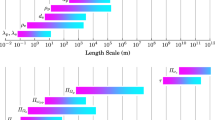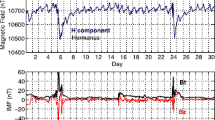Abstract
We present a spectrum of electric-field oscillations observed in situ in the solar wind by the WAVES experiment on the Wind spacecraft during the passage of a type III solar radio burst. 19 frequencies of this spectrum are compared with recent predictions of a self-similar nonlinear theory of two-dimensional electron oscillations (Osherovich and Fainberg, 2018).


Similar content being viewed by others
Data Availability
The data used in the article will be made available on reasonable request.
References
Bougeret, J–L., Kaiser, M.L., Manning, R., Goetz, K., Monson, S.J., Monge, N., Meetre, C., Perche, C., Sitruck, L.: 1995, VES: The radio and plasma investigation on the Wind spacecraft. Space Sci. Rev. 71, 231.
Dawson, J.M.: 1959, Phys. Rev. 113, 383.
Ergun, R.E., Larson, D., Lin, R.P., McFadden, J.P., Carlson, G.W., Anderson, K.A., Muschietti, L., McCarthy, M., Parks, G.K., Reme, H., Bosqued, J.M., D’Uston, C., Sanderson, T.R., Wenzel, K.P., Kaiser, M., Lepping, R.P., Bale, S.D., Kellogg, P.J., Bougeret, J.-L.: 1998, Astrophys. J. 503, 435.
Fainberg, J., Stone, R.G.: 1970, Solar Phys. 15, 433.
Ginzburg, V.L., Zheleznyakov, V.V.: 1958, Soviet Astron. 2, 653.
Gurnett, D.A., Anderson, R.R.: 1976, Science 194, 1159.
Gurnett, D.A., Anderson, R.R.: 1977, J. Geophys. Res. 82, 632.
Gurnett, D.A., Baumback, M.M., Rosenbauer, H.: 1977, Progress Report Iowa Univ., Iowa City. Dept. of Physics and Astronomy.
Gurnett, D.A., Hospodarsky, G.B., Kurth, W.S., Williams, D.J., Bolton, S.J.: 1993, J. Geophys. Res. 98, 5631.
Hospodarsky, G.B., Gurnett, D.A.: 1995, Geophys. Res. Lett. 22, 1161.
Kellogg, P.J., Goetz, K., Monson, S.J., Bale, S.D.: 1999, J. Geophys. Res. 104, 17069.
Lin, R.P., Potter, D.W., Gurnett, D.A., Scarf, F.L.: 1981, Astrophys. J. 251, 364.
Lin, R.P., Levedahl, W.K., Lotko, W., Gurnett, D.A., Scarf, F.L.: 1986, Astrophys. J. 308, 954.
Osherovich, V.A., Fainberg, J.: 2004, Phys. Plasmas 11(5), 2314.
Osherovich, V.A., Fainberg, J.: 2018, Phys. Plasmas 25, 1215.
Osherovich, V.A., Fainberg, J., Benson, R.F., Stone, R.G.: 1997, J. Atmos. Solar-Terr. Phys. 59, 361.
Polovin, R.V.: 1957, Sov. Phys. JETP 4, 290.
Stenflo, L.: 1990, Phys. Scr. 41, 643.
Thejappa, G., Lengyel-Frey, D., Stone, R.G., Goldstein, M.L.: 1995, Astrophys. J. 416, 831.
Tonks, L., Langmuir, I.: 1929, Phys. Rev. 33, 195.
Yu, M.Y., Stenflo, L.: 1996, Phys. Plasmas 3(1), 239.
Acknowledgments
We are grateful to the Wind WAVES experiment team (Dr. J.-L. Bougeret, P.I.) which made it possible to compare our theoretical results with Time Domain Sampler in situ data obtained during the passage of a type III solar radio burst. We appreciate the suggestions of the referee which have allowed us to improve the paper.
Author information
Authors and Affiliations
Corresponding author
Ethics declarations
Disclosure of Potential Conflicts of Interest
The authors declare that they have no conflicts of interest.
Additional information
Publisher’s Note
Springer Nature remains neutral with regard to jurisdictional claims in published maps and institutional affiliations.
J. Fainberg and V. Osherovich are retired, Code 673.
Appendix: Three Governing Equations for the Self-Similar Theory
Appendix: Three Governing Equations for the Self-Similar Theory
For the two-dimensional case in cylindrical coordinates, the self-similar velocity \(\vec{v}\) is the following:
where \(y(t)\) and \(f(t)\) are the scalar functions in Equations 10 and 11.
The electron density is then
where \(y_{eq}\) and \(f_{eq}\) are constants associated with equilibrium, and non-dimensional functions \(Y\) and \(F\) correspond to normalized \(y\) and \(f\), respectively. Using non-dimensional time from Equation 9 and self-similar variables \(\eta\) and \(\xi\) from Equations 10 and 11, we can present \(\vec{v}\) and \(\vec{E}\) in the following form:
Thus, the four functions \(E_{0}(\tau)\), \(E_{1}(\tau)\), \(Y(\tau)\) and \(F(\tau)\) are sufficient to find \(n_{\mathrm{e}}\), \(\vec{v}\) and \(\vec{E}\). In fact, \(E_{1}(\tau )\) is related to the other three functions algebraically (from Equation 17 in Osherovich and Fainberg (2018)):
Thus, only three functions are needed to describe self-similar oscillations. For these functions there are three governing equations:
These three equations derived in Osherovich and Fainberg (2018) have clear physical origins. Equation 17 is the radial component of the momentum Equation 2 after the separation of variables. Equation 18 corresponds to the \(z\)-component of the same momentum equation (force balance along axis of symmetry). Equation 19 comes from the z-component of Ampere’s law 4 with \(\vec{H} = 0\). Equation 16, which is algebraic, comes from the Poisson’s equation 5 (again after separation of variables) and can be viewed as the definition of \(E_{1}(\tau )\). The detailed derivation of the governing equations 17, 18, 19 is in Osherovich and Fainberg (2018). The spectrum of the electric field, \(E_{0}\), along the axis of symmetry shown in Figure 2c is calculated from the numerical solution of the system of differential equations 17, 18, 19. The initial conditions used are the following: \(F(0) = 1.151\), \(\frac{dF}{d\tau} (0) = 0\), \(Y(0) =1.29605\), \(\frac{dY}{d\tau} (0) = - 0.007\) and \(E_{0}(0) = 0.482773\). The theoretical frequencies in the fifth column of Table 1 have been found by solving the system of three equations with the above initial conditions.
Rights and permissions
About this article
Cite this article
Fainberg, J., Osherovich, V. Spectroscopy of Electric-Field Oscillations in the Solar Wind During the Passage of a Type III Radio Burst Using Observations Compared with Self-Similar Theory. Sol Phys 297, 50 (2022). https://doi.org/10.1007/s11207-022-01972-z
Received:
Accepted:
Published:
DOI: https://doi.org/10.1007/s11207-022-01972-z




